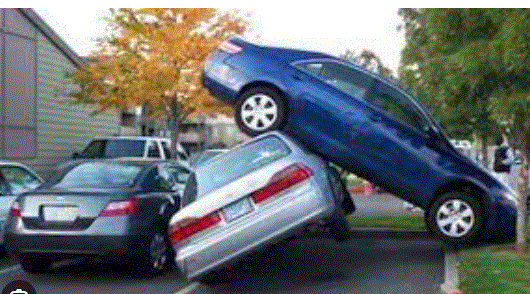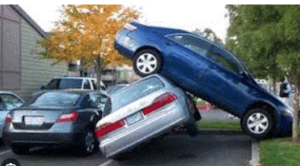
Who Is at Fault in a Car Accident When Backing Up?
Although backing up is a simple manoeuvre that accounts for about 25% of all collisions, drivers spend less than 1%
of their time doing it.
You would think that the laws governing right of way would be explicit and unambiguous given the high frequency of
collisions, but as you can see, when a driver backs into another automobile, the situation becomes hazy.
Typically, we picture fast-moving, frontal collisions when we imagine horrifying auto accidents. However, over
12,000 individuals are injured annually in backing up accidents, the majority of which occur at speeds under 10
mph. Broken bones, whiplash, and bruises are common injuries.
And then there is the blow to your insurance!
Insurance costs may rise as a result of the driver who caused the collision typically having to pay for damages.
However, it’s not always clear who is at fault when backing up. State-mandated insurance policies are also taken into
consideration by municipal and state laws, which affect the response.
Drivers in the 12 states that offer no-fault insurance might not have to decide who caused the collision. Regardless of
who is at fault, personal injury protection (PIP), also known as “no-fault insurance,” covers medical costs following
an automobile accident.
We’ll discuss a few examples below that show what occurs in the other 38 states and who is at fault in a car accident
involving backing up.
How to Determine Who Is at Fault When Backing Up
 You can determine who is at fault when backing up by referring to the right of way.
You can determine who is at fault when backing up by referring to the right of way.
Whoever did not have the right of way is typically at fault. In most cases, this will mean the car going in reverse, is at
fault.
The right-of-way is not a fixed law. It is an idea that makes traffic flow easier. You are free to drive on if you have the
right-of-way. At stop signs, vehicles yield to pedestrians, making the right-of-way clear in certain situations. It may
be muddy at other times. Who goes first if three cars simultaneously approach a four-way stop sign?
The right of way isn’t actually granted by the law. It merely specifies when it must be given up. Because of this, it can
occasionally be challenging to assign blame when driving in reverse, particularly in parking lots where most backing-
up incidents take place.
Although parking lots may appear to be pedestrian-friendly, it might be dangerous to cross one, particularly around
the holidays. The National Safety Council (NSC) reports that insurance claims increase during Black Friday and
continue to rise during the holiday shopping season. When the parking lot is packed with eager, combative
customers, it’s challenging to remain ahead of your blind area.
Parking lots, driveways, and cramming into a narrow parallel parking space are the most common locations for
backing up incidents. Thankfully, there are frequently local witnesses who can confirm what took place. A reliable
witness can offer an objective assessment and assist in determining who is at fault—you or the other motorist.
Scenarios: Hitting Another Car While Reversing
Drivers must ensure that there are no vehicles, objects, or pedestrians in their path before pulling out of a parking
space. Before letting go of the brake pedal, the parked car should take responsibility for this. In most cases, the
driving vehicle will be held accountable if two vehicles collide while one of them is parked.
Below, we’ll discuss a few situations in which the parked car might be at fault. When backing up, try not to be too
relaxed. Before reversing, it’s a good idea to check your blind spots and mirrors for obstructions, even if you go to the
same locations every day.
Backing Out of a Parking Spot into a Parked Car
The moving vehicle is usually at fault if it backs out of a parking space and collides with another vehicle. These are
quite simple examples. It will be difficult for the moving vehicle to claim they did nothing wrong if one automobile is
left parked following a two-car collision.
The parked car should be visible to the moving vehicle in time to prevent collision. If a car is parked illegally,
especially in an obscure location, it may occasionally be the driver’s fault.
Backing Out of a Parking Spot into a Moving Car
Not all cases are as straightforward as the one above. Once more, before backing up, parked cars are required to
check their blind spots and mirrors. The parked car is typically at fault when it backs into a moving vehicle.
The vehicle on the road has the right-of-way. Usually, if a parked car reverses into them, they are not held
accountable. However, they can also be responsible for some of the damages if they were speeding or acting
carelessly.
Two Cars Backing up at the Same Time
When two drivers try to back out of their parking spots at the same time, this can occur. In actuality, neither has the
right of way. Nonetheless, they still have to make sure they have a clear way to go back. Both drivers are at fault for
the collision if they are reversing and fail to see one another. Since these issues can quickly become complex,
consulting with an attorney could help you understand your options and clear up any confusion.
Is the Driver Reversing Always at Fault?
There are a few exceptions, but generally speaking, the driver who reverses is at fault. Even when a vehicle has the
right-of-way, they still have a need to exercise caution and steer clear of crashes. A driver may be liable for some of
the damages if they see a car reversing and have plenty of time to stop but decide not to.
Here are some additional situations in which the driver, even if they had the right of way, could still be held
accountable for damages.
Speeding – For over two decades, speeding has been a factor in more than one-third of traffic fatalities, according
to the National Highway Traffic Safety Administration (NHTSA). This is why drivers who speed are usually held
liable for a portion of damages after an accident.
Reckless driving – This is pretty much what it sounds like. Reckless driving is driving without regard for others’
safety or property. This includes excessive swerving, weaving, tailgating, driving on sidewalks, and ignoring traffic
signs. Reckless drivers can be held liable for a portion of damages when another driver reverses into them.
Negligence – Negligence covers a broad range of actions that show a failure to behave with reasonable judgment.
Driving under the influence or while texting or otherwise distracted and the violations listed above could all be
classified as some form of negligence.
The National Safety Council offers tips on how to stay safe and avoid collisions when backing up:
Before backing up, it’s important to do a fast 360-degree walkaround while looking for anything low to the ground.
When backing up, use your mirrors and check over your shoulder instead than depending solely on technology.
When parking, if it is feasible and compatible with traffic flow, pull through as soon as you arrive.
Read more news on https://sportupdates.co.uk/

Leave a Reply